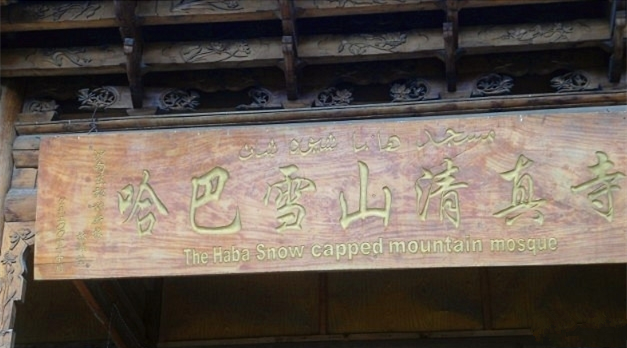
Top Muslim Mosques in Diqing
Diqing Tibetan Autonomous Prefecture (迪庆藏族自治州), known for its ethnic diversity and religious pluralism, is home to two notable and verifiable mosques. These mosques reflect the unique pattern of ethnic integration and religious coexistence in the region.
Shangri-La Mosque
Location
Located in Longwangbian Village Group (龙旺边村民小组), Haba Village (哈巴村), Sanba Township (三坝乡), Shangri-La City (香格里拉市), the mosque sits at the foot of Haba Snow Mountain (哈巴雪山), near the popular “internet-famous tree” by Heihai Lake (黑海湖).
Historical Background
Founded in 1997, this is the only Islamic site in Shangri-La City (香格里拉市), serving about 400 believers—primarily Hui (回族), with some Lisu (傈僳族) and Naxi (纳西族) Muslims. Its establishment is closely linked to Haba Village’s historical role as a key node on the Yunnan-Tibet Tea Horse Road (滇藏茶马古道). During the Ming and Qing dynasties, the area’s silver mining and commercial exchanges led to the migration and settlement of Hui people.
Current Status and Functions
The mosque covers 1,000 square meters and features a blend of Tibetan and Islamic architectural styles. It includes a prayer hall, lecture room, and cultural activity space. In recent years, the mosque has actively contributed to rural revitalization and ethnic unity by organizing policy awareness campaigns and educational events. In June 2025, the Vice Chairman of the Diqing CPPCC conducted an on-site inspection and emphasized the mosque’s role in promoting religious harmony and social stability.
Deqin Mosque
Location
Situated at No. 47, Central Street, Adunzi Community (阿墩子社区中心街 47 号), Shengping Town (升平镇), Deqin County (德钦县), the mosque lies in the core area of the Tea Horse Road (茶马古道), close to other religious sites such as Gadan Deqin Monastery (噶丹德钦林寺).
Historical Background
Deqin Mosque (德钦县清真寺) is the oldest existing mosque in Diqing (迪庆州), built during the Yongzheng reign of the Qing Dynasty (1725–1735) by Hui migrants from Shanxi (山西) and Shaanxi (陕西), who came for the Malu silver mine. It was repeatedly destroyed by natural disasters and social unrest; the current structure was rebuilt in the early Qianlong era and restored in 1987 with government funding. During a 2016 expansion, Tibetan, Han, and Naxi architectural elements were incorporated. A white pagoda was added beside the mosque, creating the unique scene of “a mosque and Buddhist stupa on one street,” symbolizing religious harmony.
Cultural Characteristics
The mosque preserves Qing-era wood carvings and plaques that record the intermarriage and integration of Hui and Tibetan people. The main congregation is composed of “Tibetan-Hui” (藏回) individuals—officially identified as Tibetans but retaining Hui customs. They wear Tibetan attire, speak Tibetan, yet strictly follow Islamic dietary laws, forming a cultural blend described as “Hui inside, Tibetan outside.” In 2023, the mosque was recognized as a Diqing model unit for ethnic unity and progress. Its facade renovation also became a provincial showcase project.
Religious Ecology and Social Significance
The existence of mosques in Diqing (迪庆) demonstrates the Islamic pattern of “small clusters, wide dispersion” in Tibetan regions. Historically, Hui Muslims migrated due to trade and mining, forming a symbiotic “Tea-Horse Market” relationship with Tibetans. Culturally, the fusion of Islamic elements with Tibetan Buddhist features—such as the white stupa at Deqin Mosque—embodies the concept of “harmony in diversity.” Today, these two mosques not only serve as spiritual centers for Muslim believers but also represent living case studies for research on ethnic interaction and interfaith dialogue along the Yunnan-Tibet corridor.

 7 Days GolfingTour
7 Days GolfingTour
 8 Days Group Tour
8 Days Group Tour
 8 Days Yunnan Tour
8 Days Yunnan Tour
 7 Days Shangri La Hiking
7 Days Shangri La Hiking
 11 Days Yunnan Tour
11 Days Yunnan Tour
 6 Days Yuanyang Terraces
6 Days Yuanyang Terraces
 11 Days Yunnan Tour
11 Days Yunnan Tour
 8 Days South Yunnan
8 Days South Yunnan
 7 Days Tea Tour
7 Days Tea Tour
 8 Days Muslim Tour
8 Days Muslim Tour
 12 Days Self-Driving
12 Days Self-Driving
 4 Days Haba Climbing
4 Days Haba Climbing
 Tiger Leaping Gorge
Tiger Leaping Gorge
 Stone Forest
Stone Forest
 Yunnan-Tibet
Yunnan-Tibet
 Hani Rice Terraces
Hani Rice Terraces
 Kunming
Kunming
 Lijiang
Lijiang
 Shangri-la
Shangri-la
 Dali
Dali
 XishuangBanna
XishuangBanna
 Honghe
Honghe
 Kunming
Kunming
 Lijiang
Lijiang
 Shangri-la
Shangri-la
 Yuanyang Rice Terraces
Yuanyang Rice Terraces
 Nujiang
Nujiang
 XishuangBanna
XishuangBanna
 Spring City Golf
Spring City Golf
 Snow Mountain Golf
Snow Mountain Golf
 Stone Mountain Golf
Stone Mountain Golf



















